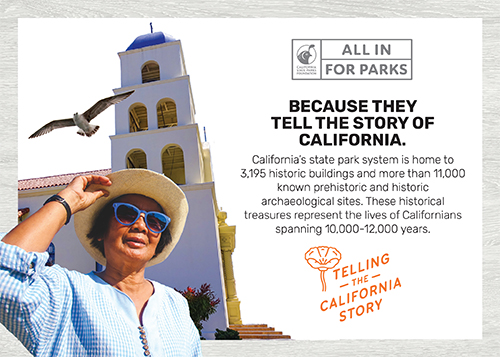You can tell the history of California through state parks.
- California’s historic sites and heritage is preserved and honored through our state parks. Each park has a story to tell that fits into the greater history of the Golden State, and there is so much to learn from these places.
- The story of our California is woven into the fabric of our 52 state historic parks. They are destinations for students and teach us about Californian’s history and statehood.
- California Department of Parks and Recreation cares for museum objects as diverse as freight wagons and delicate feathered baskets of over one million museum objects, two million archaeological specimens and three million archival documents in more than 120 parks and curatorial facilities statewide.
- California’s state park system manages the largest and most diverse natural and cultural heritage holdings of any state in the country.
- California state parks partners with California Indian tribes throughout the state to support cultural activities.
These state parks bring our complex history and important figures from our past to life and promote greater understanding and appreciation for our state’s diversity. These resources include:
- Weaverville Joss House State Historic Park: The Joss House was built in 1874 on site of earlier temple.
- Chumash Painted Cave State Historic Park: The sandstone cave houses at this park depict religious drawings by Chumash Native Americans, as well as likenesses of coastal fishermen that date back to the 1600s. Found above Santa Barbara in a steep canyon, the site preserves these fine examples of Native American art on the side walls of the rock shelter.
- El Presidio de Santa Barbara State Historic Park Cañedo Adobe, 1782: part of Spanish Presidio; El Cuartel, 1788 – only remaining intact building of the Santa Barbara Presidio.
- Colonel Allensworth State Historic Park founded in 1908: California's Only Town Founded, Financed and Governed by African Americans.
- Angel Island State Park: Three thousand years ago the island was a fishing and hunting site for Coastal Miwok Indians. From 1910 to 1940, the island processed hundreds of thousands of immigrants, the majority from China. During World War II, Japanese, and German POWs were held on the island, which was also used as a jumping-off point for American soldiers returning from the Pacific. In the '50s and '60s, the island was home to a Nike missile base.
- Bodie State History Park: The park offers a glimpse of California’s Gold Rush heritage. Once a boomtown (at one time, more than 60 saloons lined mile-long Main Street), the park is now an authentic Wild West ghost town.
- Sutter’s Fort State Historic Park: The park features the oldest restored fort in the United States, originally built by John Sutter in 1840’s.
BY THE NUMBERS
52
of California's 280 state parks are historic parks.
